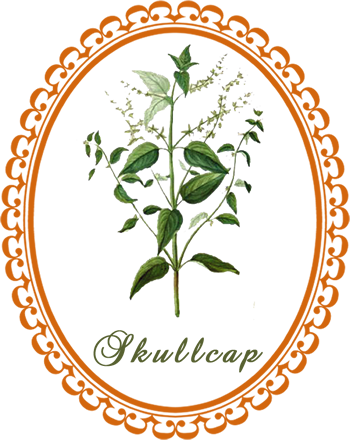
Skullcap: by its actions through the cerebrospinal centers, is a most valuable remedy for controlling nervous irritation. It relaxes states of nervous tension while at the same time renews and revives the central nervous system...
Common Names: Skullcap, Scullcap, Helmet Flower, Mad Dog Weed
Botanical Name: Scutellaria lateriflora
Family: Lamiaceae
Plant Type: Perennial
Parts Used: Dried aerial parts
Flowering: May to August
Indigenous to eastern North America, Scutellaria lateriflora grows wild in damp woodlands, thickets, swamplands and along riverbanks. It is widely cultivated in Europe and other parts of the world.
Description: A slender, heavily branched perennial growing one to three feet high, skullcap has small pointed leaves with toothed edges, and numerous two-lobed, violet-blue (sometimes pink or white) flowers produced in one-sided racemes (flowers borne on short stalks along an elongated axis).
Cultivation: Skullcap will grow in ordinary garden soil in sun or part shade, but is a moisture-loving perennial that does best in damp conditions. It can be propagated by seed, by division, or by cuttings.
Harvesting: Collect the above-ground parts in June from three-to four-year old plants. The whole plant is medicinal and should be gathered while in flower, dried in the shade, and kept in well-closed tin vessels, as it deteriorates rapidly from age and heat.
Skullcap Magick
Love. Fidelity. Peace.
Gender: Feminine
Planet: Saturn
Element: Water
Use skullcap in spells of relaxation and peace.
Burn skullcap as an incense to fill your home with a sense of relaxation and peace.
A woman who wears skullcap protects her husband against the charms of another woman.
Before a wedding ceremony, sprinkle the dried plant around the area where the vows will be spoken to ensure a long and happy marriage.
Herbal Healing with Skullcap
Medicinal Actions: antispasmodic, astringent (mild), emmenagogue, hypotensive, sedative, nervine, tonic (nervous system)
Medicinal Uses: Skullcap works primarily on the nervous system. Is acts as a sedative, both mentally and physically, to calm and sustain an over-excited system. It can be used where there is stress and tension present. It has been used to treat epilepsy, hysteria, delirium tremens, Saint Vitus' dance (a neurological disease later called Sydenham's chorea), insomnia, and withdrawal from various drug addictions. This herb can lower blood pressure and ease muscle tension and spasms such as occur with Parkinson's disease. The herb is being used to treat ADD and similar disorders. It has also been effective for anorexia, fibromyalgia, restless leg syndrome, mild cases of Tourette's syndrome (a condition characterized by motor and vocal tics) and seizures.
Skullcap's sedative effect also helps to alleviate period or ovarian pain. It is an emmenagogue and is used to promote menstruation. Studies have shown that it eases inflammation and the release of histamines. It is also effective in reducing temperature and inducing perspiration in feverish children. The infusion can be taken to treat throat infections, nervous headaches, neuralgia, pain and as a sedative.
One of this plant's common names is mad dog skullcap, referring to its traditional use in North America for hydrophobia or rabies; the herb may have helped moderate the symptoms, but did not cure the disease.
The Chinese blend skullcap with stinging nettle for an herbal remedy for hay fever.
Cautions:
- Pregnant women should not take skullcap, as it can induce a miscarriage.
- Overdosing can cause stupor, giddiness, twitching and confusion.
- Occasionally you may experience cramping or diarrhea.
Preparation and Dosage:
To make a medicinal herbal tea, add 1 tablespoon of skullcap to 1 cup of water at the boiling point. Steep this solution for 15 minutes. For severe forms of anxiety, 3 to 6 cups of this herbal tea can be taken for a day or two. After that, the dosage must be reduced to 2 to 3 cups per day as needed. For long term use or for less severe cases, take 1 to 3 cups per day.
If you are taking a tincture, ¼ to 1 full teaspoon of tincture can be taken 2 to 4 times per day, depending on your response to the herb. Start with the lowest dose and gauge your reaction before increasing.
If you prefer capsules, take 2 capsules 2 to 4 times per day as needed.
Herbal Combinations with Skullcap
To make a calming herbal tea, combine skullcap with passionflower (Passiflora), chamomile (Matricaria) and lemongrass (Cymbopogon citratus) and steep for 15 minutes. After straining, this tea can be taken throughout the day without worry.
Combine skullcap with other nervous-system healers like wild oats (Avena), verbena (Verbena), and St. John's wort (Hypericum)
For a more tranquilizing effect, combine skullcap with Passionflower (Passiflora), California poppy (Eschscholzia), and valerian (Valeriana)
For premenstrual tension, combine skullcap with chaste berry (Vitex) and German chamomile (Matricaria)
For depression, try skullcap combined with borage (Borago), St. Johns wort (Hypericum) and licorice (Glycyrrhiza)
If you appreciate the information provided,
please help keep this website running. Blessings!
© 2008-2025 aromaworx.ca. All rights reserved.

